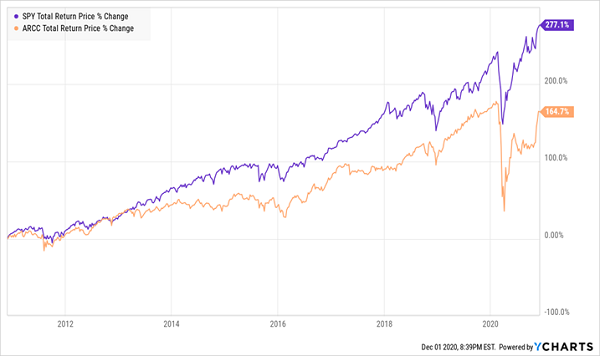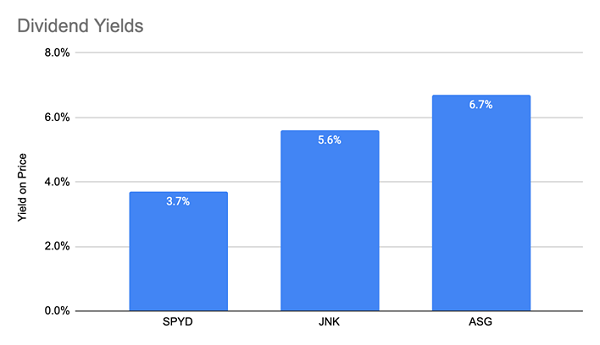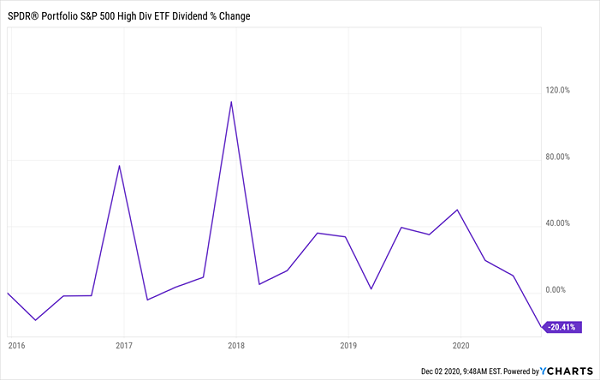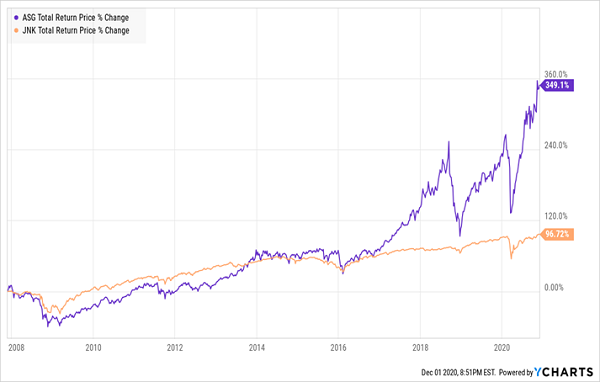If you’re like most people these days, you’re desperately searching for any kind of meaningful dividend stream.
Finding one is no easy task. The S&P 500, after all, yields 1.5%, on average. Treasuries? With their 0.9% yields, they’re not even worth talking about.
With the old income go-tos off the table, plenty of folks are looking further afield. Some are boosting their holdings of high-yield bonds through exchange-traded funds like the SPDR Bloomberg Barclays High Yield Bond ETF (JNK). Others are going with more esoteric investments, like high-yielding business development companies (BDCs), which you can tap through the UBS Etracs Business Development Company ETN (BDCS).
On the dividend-growth front, there’s the SPDR S&P 500 High Dividend ETF (SPYD), which yields more than the broader index, but still a relatively low 3.7%.
Let’s take a look at these three (increasingly) popular funds and stack them up with a fourth, lesser-known contender: the Liberty All-Star Growth Fund (ASG), a closed-end fund (CEF) yielding much more than SPYD and many other big yielders out there. As we run through the comparisons and eliminate one fund with each step we take, it’ll become clear which one you should consider for your portfolio.
Test #1: Portfolio Quality
Let’s start with the top holding of our junk-bond ETF, JNK: a 7.4%-yielding bond issued by Altice France S.A. I think you’ll agree that Altice is far from a household name in America. Its home country, France, isn’t a great place for your money, either, considering its decades of lackluster economic growth.
Our high-yield stock ETF, SPYD, has Invesco (IVZ) as its top holding. Invesco is an investment manager with over $1.2 trillion in assets and is also a major ETF issuer.
Then there’s ASG’s biggest holding, Paylocity (PCTY), a relatively young upstart that’s seen strong revenue growth as it takes a greater share of the payroll-management industry.
All three of the above funds’ top holdings are much better than what you’d get with BDCS, which is technically nothing because this investment doesn’t hold any investments at all! As an ETN, not an ETF, it simply tracks an index of assumed assets without buying any of them. But UBS, the ETN’s issuer, promises to give investors dividends matching the yields on the stocks it tracks over time.
That should raise a red flag right there, but even if we ignore it for argument’s sake, BDCS’s portfolio is worrying. The biggest stock it tracks, Ares Capital Corporation (ARCC), is one of the biggest BDCs, investing in 347 companies. That diversity is promising on its surface, but ARCC’s last decade has been disappointing.
S&P 500 Runs Over BDCS’s Biggest Holding

The smaller companies ARCC invests in should help it deliver a superior return, but we aren’t seeing that. So, combined with the red flags around the ETN’s structure and the fact that it doesn’t really own any of its constituents, we can cut BDCS, and ETNs in general, from our list.
Test #2: Dividend Yield
With three funds remaining, let’s look at dividend payouts.

Source: CEF Insider
From this chart alone, it’s obvious that SPYD is the odd one out, with its relatively low 3.7% dividend. But remember that it focuses on dividend growth, so we need to dig deeper. If we buy now and hold SPYD for 10 years, will the yield on our investment at the end of that period be larger than ASG’s 6.7% payout is now?
There’s no way to answer that definitively, and there is reason to believe SPYD’s payout will rise after this crisis ends. But we need to invest both inside and outside of crises, so we need to see SPYD keep its payouts stable throughout this crisis and show strong potential for payout growth in the long run. Unfortunately, that hasn’t been the case:
SPYD’s Dividend Gives Way Under Pressure

SPYD’s crashing payouts in 2020 show that it’s a fairweather friend. But even if we’re generous and project that its payout will grow 50% in the next decade, we’d be getting 5.6% at that time, just barely as much as JNK. Meanwhile, we’ll have a decade of inferior payouts to put up with. So let’s cut SPYD from our list.
Test #3: Total Returns
Now for the most important question: which fund will make us richer in the long run? By looking at total return—or capital gains plus dividends collected—we can clearly see which outperforms. Between JNK and ASG, the winner is clear.
ASG Wins by a Mile

For as long as both funds have been around, ASG has been the winner.
But we can’t end our competition there. Total return is so important, we should compare all of our funds based on it. Is ASG still the winner?
ASG Vs. Everybody

For as long as all of these options have existed, ASG has crushed them. In dollars, $100K put in ASG is now worth $274,300, while that same amount is worth just $135,570 in the runner-up (SPYD) and even less with the other duds.
The 5 Best CEFs for 2021—8% (Monthly) Dividends, 20% Gains Ahead
The funny thing about ASG is that its 6.7% payout isn’t even that big as CEFs go. It’s actually below the average payout of 7% for all 500 or so CEFs in existence!
So by going just one step further, we can easily boost our yield to a gaudy 8%. And here’s one more thing to consider: the vast majority of CEFs pay dividends monthly, too! As I write this, about 380 of these income machines send out a dividend every 30 (or 31) days.
Your Roadmap to Huge Cash Payouts in 2021
That brings me to the 5 CEFs I’m pounding the table on for 2021: these dynamic funds all pay generous 8% dividends and they’re all cheap now—trading at totally unusual discounts that have them primed for 20%+ price upside in 2021, and that’s in addition to their steady 8% dividend payouts!
I’ve named these funds in an exclusive special report I want to share with you now. Don’t miss your chance to grab it. Go right here and get your copy, which will reveal all the critical data you need on these 5 income plays: names, tickers, best-buy prices, complete dividend histories, my in-depth analysis of management and more.

Recent Comments